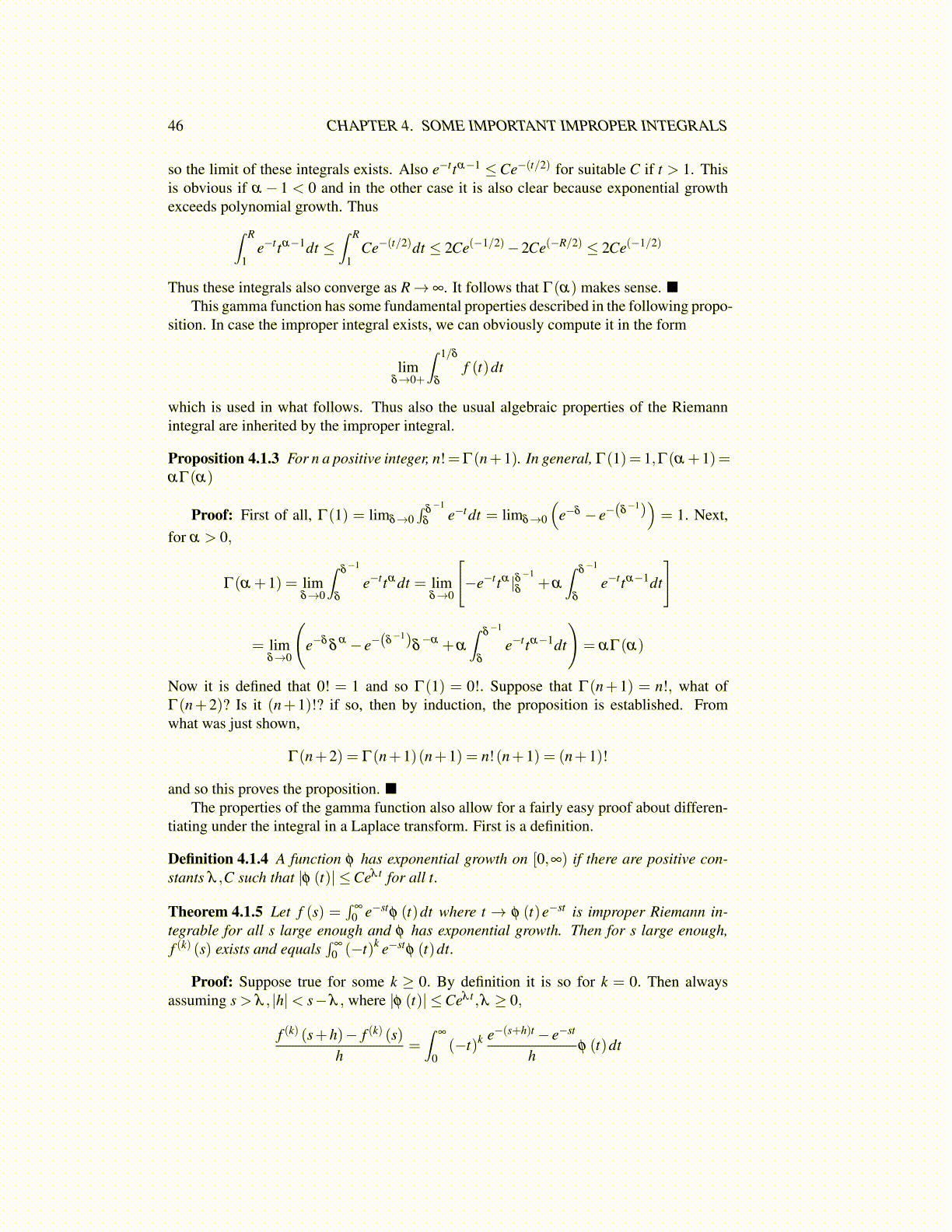
46 CHAPTER 4. SOME IMPORTANT IMPROPER INTEGRALS
so the limit of these integrals exists. Also e−ttα−1 ≤Ce−(t/2) for suitable C if t > 1. Thisis obvious if α − 1 < 0 and in the other case it is also clear because exponential growthexceeds polynomial growth. Thus∫ R
1e−ttα−1dt ≤
∫ R
1Ce−(t/2)dt ≤ 2Ce(−1/2)−2Ce(−R/2) ≤ 2Ce(−1/2)
Thus these integrals also converge as R→ ∞. It follows that Γ(α) makes sense. ■This gamma function has some fundamental properties described in the following propo-
sition. In case the improper integral exists, we can obviously compute it in the form
limδ→0+
∫ 1/δ
δ
f (t)dt
which is used in what follows. Thus also the usual algebraic properties of the Riemannintegral are inherited by the improper integral.
Proposition 4.1.3 For n a positive integer, n!=Γ(n+1). In general, Γ(1)= 1,Γ(α +1)=αΓ(α)
Proof: First of all, Γ(1) = limδ→0∫
δ−1
δe−tdt = limδ→0
(e−δ − e−(δ
−1))= 1. Next,
for α > 0,
Γ(α +1) = limδ→0
∫δ−1
δ
e−ttα dt = limδ→0
[−e−ttα |δ
−1
δ+α
∫δ−1
δ
e−ttα−1dt
]
= limδ→0
(e−δ
δα − e−(δ
−1)δ−α +α
∫δ−1
δ
e−ttα−1dt
)= αΓ(α)
Now it is defined that 0! = 1 and so Γ(1) = 0!. Suppose that Γ(n+1) = n!, what ofΓ(n+2)? Is it (n+1)!? if so, then by induction, the proposition is established. Fromwhat was just shown,
Γ(n+2) = Γ(n+1)(n+1) = n!(n+1) = (n+1)!
and so this proves the proposition. ■The properties of the gamma function also allow for a fairly easy proof about differen-
tiating under the integral in a Laplace transform. First is a definition.
Definition 4.1.4 A function φ has exponential growth on [0,∞) if there are positive con-stants λ ,C such that |φ (t)| ≤Ceλ t for all t.
Theorem 4.1.5 Let f (s) =∫
∞
0 e−stφ (t)dt where t → φ (t)e−st is improper Riemann in-tegrable for all s large enough and φ has exponential growth. Then for s large enough,f (k) (s) exists and equals
∫∞
0 (−t)k e−stφ (t)dt.
Proof: Suppose true for some k ≥ 0. By definition it is so for k = 0. Then alwaysassuming s > λ , |h|< s−λ , where |φ (t)| ≤Ceλ t ,λ ≥ 0,
f (k) (s+h)− f (k) (s)h
=∫
∞
0(−t)k e−(s+h)t − e−st
hφ (t)dt